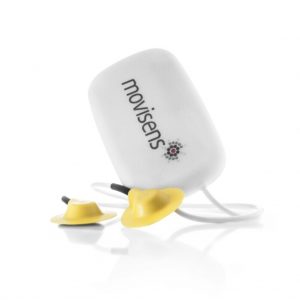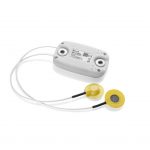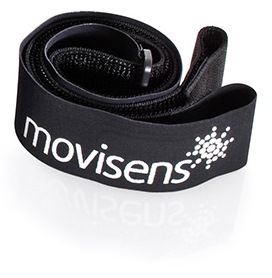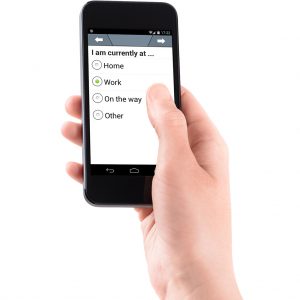EdaMove 3 – EDA and Activity Sensor
The EdaMove 3 provides researchers with the most comprehensive tool for recording and analysing Electrodermal (Galvanic Skin Response) and physical activity. Capable of capturing up to 4 weeks of data, the EdaMove 3 allows researchers to isolate and understand emotional affect with greater clarity than before.
The EdaMove 3 combines our acclaimed accelerometers (featured in all our Move 3 range sensors), a high quality EDA sensor, and a Bluetooth Smart interface that allows the sensor to interact with our class leading Experience Sampling Platform movisensXS to trigger questionnaires based on changes in physiological parameters.
The sensor acquires the raw data of the EDA and the 3D acceleration of a test subject allowing secondary parameters like skin conductance level (SCL), skin conductance responses (SCR), and activity intensity to be calculated with the movisens DataAnalyzer software.
Capturing motion, barometric pressure and temperature allows a more precise analysis of the data. These parameters allow artefacts that normally hinder the analysis of EDA data in an ambulatory setting to be identified, and isolated accordingly. The sensor is worn with a wristband on either the wrist or ankle and comes with multi-use, non-polarizing sintered Ag/AgCl electrodes.
View latest version
Apply for free student project
Top-Features
- Live analysis of data on the sensor
- Bluetooth-Smart Interface
- Complies with all relevant EDA-standards
- Perfect signal quality in everyday life
- Includes 3D acceleration sensor for the acquisition of physical activity and context information
- Sustainable data format
- Practical and easy to use in studies
- Java API for USB (Windows)
- API: Example implementation for Bluetooth Smart (Android)
Applications
- Interactive ambulatory assessment
- Mobile long-term monitoring of EDA (elecrodermal activity) / GSR (galvanic skin response)
- Psycho physiologic monitoring
- Research of the autonomic nervous system (ANS)
- Behavioral monitoring
- Work and Organisational Psychology
- Clinical Psychology
- Affective Computing
- Integration into complex systems possible
Matching products and services

SensorTrigger
movisensXS-Feature for Interactive Assessment
Activity triggered eDiaries and Event Contingent Sampling
Downloads
| Newsletter |
|
|---|---|
| Software |
|
| Documentation |
|
| Data Examples |
|
| External Tools |
Technical data
|
Power supply |
Lithium-Polymer-Battery |
|
Battery voltage |
3,0 - 4,2 V |
|
Number of charging cycles |
300 (with 1C/1C > 80%) |
|
Internal memory |
4 GB |
|
Maximum recording capacity |
4 weeks |
|
Battery run time |
~ 5 days |
|
Recharging time |
~ 1 hour |
|
Size of sensor (W x H x D) |
62,3 x 38,6 x 11,5 mm |
|
Weight of sensor |
31 g |
|
Internal sensors |
EDA sensor: Exosomatic method, constant voltage, DC, 0,5V Resolution: 14 bit, Input range 2 µS up to100 µS Bandwith: DC to 8 Hz Output rate: 32 Hz 3D acceleration sensor: Measurement range: +/- 8 g Noise: 4 mg Output rate: 64 Hz Pressure sensor: Measurement range: 300 - 1100 hPa Noise: 0,03 hPa Output rate: 1 Hz Temperature sensor: Output rate: 1 Hz |
|
Live analysis |
EDA SCL mean Temp mean Movement Acceleration Step count charging State of charge |
|
Indicators |
LED, 3-color Vibration alarm Marker |
|
Interfaces |
Micro-USB, Bluetooth Smart (4.0) |
|
API |
Java API for USB (Windows) Example for Bluetooth Smart (Android) |
|
Wear location |
Wrist, Ankle |
|
Environmental conditions |
Temperature: -20 °C to 60 °C 0 °C to 45 °C during charging Humidity: 0 to 75 % Relative Humidity Atmospheric pressure: 300 to 1100 hPa absolute |
|
Warranty |
1 year |
Literature
- A Comparison between Laboratory and Wearable Sensors in the Context of Physiological Synchrony.
- Moments That Matter? On the Complexity of Using Triggers Based on Skin Conductance to Sample Arousing Events Within an Experience Sampling Framework..
- Evaluating Usability Aspects of a Mixed Reality Solution for Immersive Analytics in Industry 4.0 Scenarios.
- Social anxiety is associated with heart rate but not gaze behavior in a real social interaction..
- Measuring Behavior 2020-21.
- Physiological synchrony in EEG, electrodermal activity and heart
rate reflects shared selective auditory attention. - Applicability of Immersive Analytics in Mixed Reality: Usability Study.
- Electrodermal activity patterns in sleep stages and their utility for sleep versus wake classification.
- A mixed-methods study of physiological reactivity to domain-specific problem solving: methodological perspectives for process-accompanying research in VET.
- Estudo piloto em câmara climática: efeito da luz natural em aspectos de saúde e bem-estar não relacionados à visão.
- Detecting cognitive underload in train driving: A physiological approach.
- Mobile Sensors for Multiparametric Monitoring in Epileptic Patients.
- A personalized and reconfigurable cyberphysical system to handle multi-parametric data acquisition and analysis for mobile monitoring of epileptic patients.
- Evaluation of environmental effects on the measurement of electrodermal activity under real-life conditions.
- Komfortgewinn für Passagiere auf Langstreckenflügen durch den Einsatz chronobiologisch angepasster LED-Kabinenbeleuchtung.
- Publication recommendations for electrodermal measurements.
You can find more publications here.










